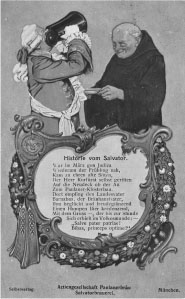Doppelbock is a strong beer with minimum original gravity of 18 degrees Plato and a typical alcohol content beyond 7% ABV. The style originated in the Bavarian capital city of Munich, Germany and was for a fairly long time synonymous with the Salvator beer brewed by Paulaner. In the late 19th-century breweries that had copied the name “Salvator” were forced by a lawsuit to introduce their own brands of doppelbock beers, but Salvator remained the category defining beer. The beer originated in a convent in the village Au on what used to be the eastern outskirts of Munich in the 17th century when monks following the rule of Saint Franciscus of Paula settled there and began brewing beer. The “Sanct Pater Bier” (later “Salvator”), brewed to celebrate father Franciscus’ commemoration day on April 2, was first brewed by Valentin Stephan Sill, called “Frater Barnabas,” in 1774. It was a custom to offer a mug of this strong beer to the duke of Bavaria, toasting in Latin: “Salve, pater patriae! Bibes, princeps optimae!” (“Greetings to you, father of our country! Drink, best of all noblemen!”). While the duke was finishing his strong beer (wisely drinking only a small sip at a time) Frater Barnabas was allowed to speak his mind freely. This is re-enacted every year on the Nockherberg when the tapping of the first barrel of Salvator officially marks the middle of the lent period before Easter. Also known as “liquid bread,” this beer once helped the monks through the long fasting days of Lent. While Salvator is the most well-known doppelbock, almost 200 other breweries indicate the style by amending “-ator” to the beer’s name. Famous doppelbocks are “Animator” (Hacker Pschorr), “Celebrator” (Ayinger), “Impulsator“ (Wieninger), “Maximator” (Augustiner), “Palmator” (Prösslbräu), and “Triumphator” (Löwenbräu). Yet there are noteworthy exceptions to that naming convention including “Andechser Doppelbock” and the top fermenting strong weissbier, “Aventinus” from Schneider.

Benedictine monks of the order of Saint Francis of Paola began brewing in Munich in 1634 with permission from the Duke of Bavaria, initially only for their use. But by 1780 they were also selling their brews as extra strong beer under the name of Salvator (Latin for “Savior”) to the public. Strong beer called bock (“Billy goat”) had been brewed in Munich since 1612, so the monks called theirs dopplebock (“two Billy goats”). pike microbrewery museum, seattle, wa
While they can be brewed to any color and made by different methods, doppelbocks are usually reddish-brown bottom-fermented lagers, and generally show a toffee-like, bready aroma and rich malty palate with notable residual sweetness. Hops are usually robust enough to offer some balance, but rarely above 25 IBU.
